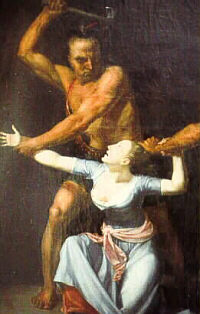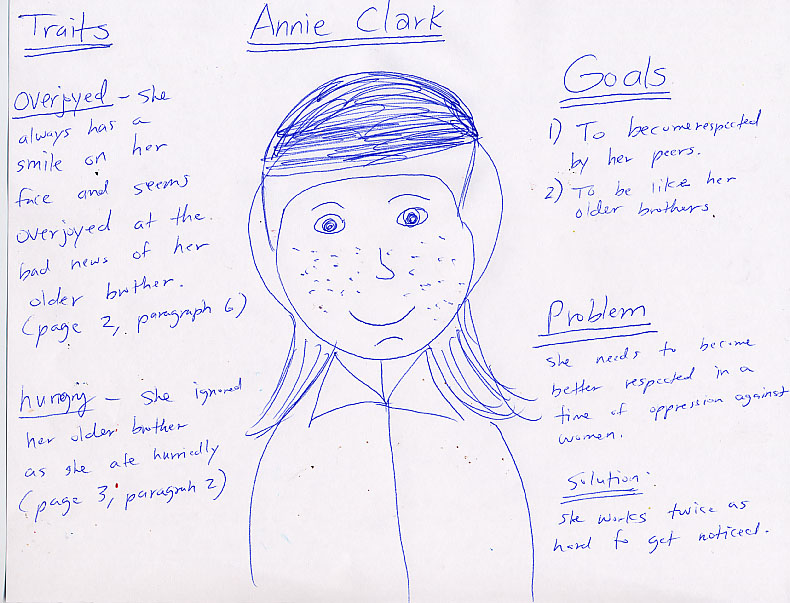A NOVEL OF REBELLION
By: Paul Samuel Jacobs

picture: http://earlyamerica.com/review/1998/scalping.html

Fifth Grade (above grade level)
Section 2 (pages 28-66)
Discussion Director
Your job is to develop a list of questions that your group will discuss
about this part of the book. You may come up with your own qestions,
or you may chose from the sample questions.
1 MCEOG
1 Cause/Effect
1 Character
1 Figurative Language
1. Which of the following does not describe Annie Clark?
A. Imprudent
B. Huge smile
C. Ugly
D. Witty
Answer: C (page 3, paragraph 2)
2. What caused the horse to rear and stop in the path?
Answer: James walked right into the path of the wagon.
(page 33, paragraph 2)
3. When James says: "I know you", who is he referring to?
Answer: King Phillip (page 33, paragraph 6)
4. What is Bartholomew referring to when he is saying: "Half-brother!
Half-Wit!"
Answer: Sam (page 39, paragraph 3)
Passage Picker
Section 2 (pages 28-66)
Your job is to pick passages from this section that you and your group
can talk about.
1) Pick out passage you would like to share
2) Write down the page and paragraph number
3) Write down the entire passage being used
4) Write down the first two words and the last two words of your passage
5) Write down the reason you chose the passage and explain why
6) Ask a question about your passage and give an answer
7) Write down the Author's purpose
Choose passages that satisfy these four reasons:
Foreshadowing
Figurative language
Description
Morality
Here are three examples:
1. Foreshadowing
2. pages 34-35, last paragraph-first paragraph
3. “And whatever…our skin.”
4. This passage deals with the problem of noticing the differences
of different races. In this case Native American with English Settlers.
5. Q: Why did King Phillip make this remark?
A: It is obvious that King Phillip is foreshadowing the conflict
to come between the English Settlers and his tribe as well as other tribes.
6. The author’s purpose behind this I feel is to allow the reader
to try and understand the age old problem of different races and cultures
trying to get along.
1. Figurative language
2. page 39, paragraph 3
3. “Now Sam…fool complete!”
4. This passage is a good connection to talk about between the
relationship between a mother and her son.
5. Q: Why does Bartholomew feel compelled to say something
of spite towards Sam?
A: Bartholomew retaliates with insulting words to protect the
honor of his mother.
6. The author’s purpose is not only to show the relationship
between a mother and son but also has figurative language in it as well.
1. Description
2. page 47, paragraph 2
3. “There will…the sky?”
4. This passage is indicative of how superstitious people were
of this time.
5. Q: Why does Goody feel compelled to mention the comet
in the sky?
A: He does so to reinforce the idea that war is imminent because,
according to the signs in the sky, it
was meant to be.
6. The author’s purpose for this is to describe the feelings
of many of the people of this time and how they might have used a comet
in the sky as a superstitious to predict the future.
.
Character Sketcher
Section 2 (pages 28-66)
Your job is to find an interesting character from this section you
read today. You will find three words that describe the character.
For each word, or character trait, you will give the proof or example (including
page and paragraph). The next thing you will do is tell one of character’s
goals, or what the character wants to do in this section. Then you
will find one of the character’s problems in the section and the solution
or possible solution to the problem. Finally, you get to have fun
and illustrate your character!

Character Traits:
1. Overjoyed (page 2, paragraph 6): She always seems
to have a smile on her face and seems overjoyed when she gets excited about
something.
2. Hungry (page 3, paragraph 2): She ignored her
older brother to inhale her food faster than anyone else.
3. Brunette (page 3, paragraph 2): She is referred
to as dusted with freckles and her long brown hair.
Goal: To become more respected by her peers and her family and to become successful like her older brother and cousin.
Problem: She wants to become a respected person in society but it is a time of oppression against women.
Solution: She works twice as hard to get noticed by her
peers.
Word Wizard
Section 2 (pages 28-66)
Your job is to look for special words in the story. On your recording
sheet, write down the following:
1. Write down the word
2. Copy the sentence from the book in which the word appears
3. Look up the word in the dictionary
4. Using context clues from the sentence and the dictionary definition,
write down in your own words the definition of the word
5. Write down the correct part of speech (noun, verb, adjective, adverb)
6. Write a sentence of your own with word in it.
7. Make your word wizard card. Be sure to include in big print
your word and the page and paragraph number. On the other side of
the card should be a picture, the word, and the definition of the word.
1. defilement (page 29, paragraph 3)
2. “You have touched a sacred book!” the man said, his anger
growing. “It is a defilement!”
3. Defile: 1. To make foul, dirty, or unclean; pollute;
taint. 2. To violate the chastity of. 3. To make impure for
ceremonial use; desecrate. 4. To alter or defoilen; trample on; violate.
4. Defilement: Making something unusable by tainting it.
5. Noun
6. To burn the Bible is a defilement.
7. Have the kids make a Word Wizard Card
1. shillings (page 29, paragraph 7)
2. “Eight shillings for you,” the store owner said.
3. Shilling: 1. A cupronickel coin of the United
Kingdom, the 20th part of a pound, equal to 12 pence; use phased out in
1971. 2. A former fractional currency of various other nations and
territories, as Ireland, Jamaica, Nigeria, etc.
4. Shilling(s): The money used in this time period
by the English Settlers
5. Noun
6. That book cost me ten shillings.
7. Here is an example of a Word Wizard Card:
Two other possible words to be used:
1. finery
2. wharves
Investigator
Your job is to dig up some background information on any topic related
to your book. This might include:
I chose these web sites because they are very accurate on the actual
happenings of King Phillip's War. I feel that this book comes very
close to becoming historically accurate in that in creates characters that
maintain the tradition of what really happened in this time period.
A good start to this is to read the Afterward on pages 217-220. Then,
I would ask the question of myself how how true is this story to what actually
happened? A good research includes many different kinds of sources
of which some are included above on the web.